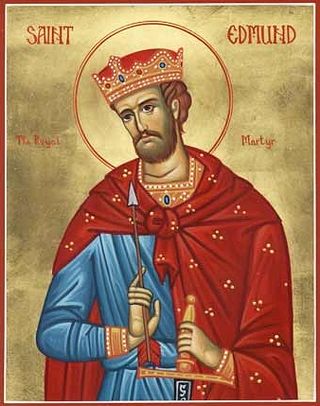
The patron saint of our Community is St. Edmund, King and Martyr.
Edmund was born c. 841 and began his reign as King of the East Angles on Christmas day c.855. He was well known for his piety and holiness as one of his early biographers, AElfric of Eynsham, recorded in the Passion of St. Edmund.
“The Blessed Edmund, King of the East Angles, was wise and honourable, and always worshipped the Almighty God with noble living. He was humble and distinguished, and he continued so steadfastly that he would not turn to shameful vices, nor did he incline his disposition to either side of the golden mean, but he was always mindful of the true doctrine … To the poor and widows he was charitable like a father, and with benevolence always guided his people to righteousness.”
In c.869, St. Edmund’s kingdom was invaded by the Vikings. The Viking King lvar sent a delegation to Edmund with the following message:
“Ivar our king, brave and victorious on sea and land, has rule over many people, and has just landed suddenly with an army here to have winter quarters with his host. He now commands thee to share with him without delay thy hidden treasures and thy ancestral possessions, and thou shalt be his tributary king, if thou wilt live, for thou hast not the strength to resist him.”
To this message, St. Edmund replied to lvar’s delegation:
“Truly, you were now worthy of death, but I do not wish to defile my clean hands in your impure blood, because I follow Christ who so gave us example; and I will happily be slain by you if God so decrees it. Go now instantly and tell your fierce lord, ‘Never in his life will Edmund submit to Ivar, a heathen chieftain, unless first of all he submit to the saviour Christ with faith in this lance.'”
This reply angered Ivar, so he came with his pirates to kill King Edmund. As is recorded:
“When Ivar came, King Edmund stood within his hall, mindful of the Saviour, and threw away his weapon; he wished to imitate Christ, who forbade Peter from fighting the Jews. Then the wicked men bound Edmund and insulted him shamefully and beat him with rods. And so afterwards they led the faithful king to a tree fast in the earth and tied him to it with strong bonds, and again beat him for a long time with whips; and between the strokes he always called with unshaken faith to the saviour Christ … Then they shot him with missiles [arrows or spears], as if for their sport, until he was entirely surrounded by their shots, like the spines of a hedgehog … Then Ivar, the cruel pirate, saw that the noble king would not deny Christ, but with resolute faith always affirmed him. Then Ivar commanded them to behead him, and the heathens did so.”
The Vikings threw his head in brambles away from the body. Following his martyrdom many miracles were performed by St. Edmund. The first of which was that God had sent a wolf to protect the saint’s head and to aid the faithful in recovering it. St. Edmund’s head was then buried with his body. Many years later after peace was restored in East Anglia, the people built a church dedicated to St. Edmund. When they had exhumed his body to move it into the church:
“[T]here was a great wonder that he [St. Edmund] was entirely as fresh as if he were alive, with an uncorrupted body, and his neck, which had been cut through, was healed, and there was as it were a silken thread about his red neck, as an indication to the world how he had been slain. Also the wounds, which the heathens had inflicted on his body with their frequent shots, were healed through the grace of the Heavenly God … His body which lies undecayed, tells us that he lived here in the world chaster and went to Christ with stainless life.”
St. Edmund’s feast is held on November 20th, the day he was martyred. He is the patron of our community, and we rely on his prayers for the growth of our community. St. Edmund is also a powerful example of how the Gospel may be lived out in a courageous way. As a king, Edmund ruled his people well, acting as a father toward them and thereby imitating God’s Fatherly love for us. As a martyr, St. Edmund shows the deep dedication that we are all called to have towards Christ. The saint never denied Christ, even when he was surrounded, and when the easy path to surrender was offered to him, he rather chose to try to convert his enemies from their pagan beliefs rather than submit to them. It was this action that eventually cost him his life. The miracle of St. Edmund’s uncorrupt body reminds us of Christ’s words “whosoever will lose his life for my sake shall find it.” (Matthew 16:24) as well as that we believe in “the resurrection of the body, and the life everlasting. Amen.”
Sancte Edmunde, ora pro nobis!
The above quotes are from: The Anglo-Saxon World: An Anthology – translated and with
an Introduction by Kevin Crossley-Holland, and published by Oxford University Press.

